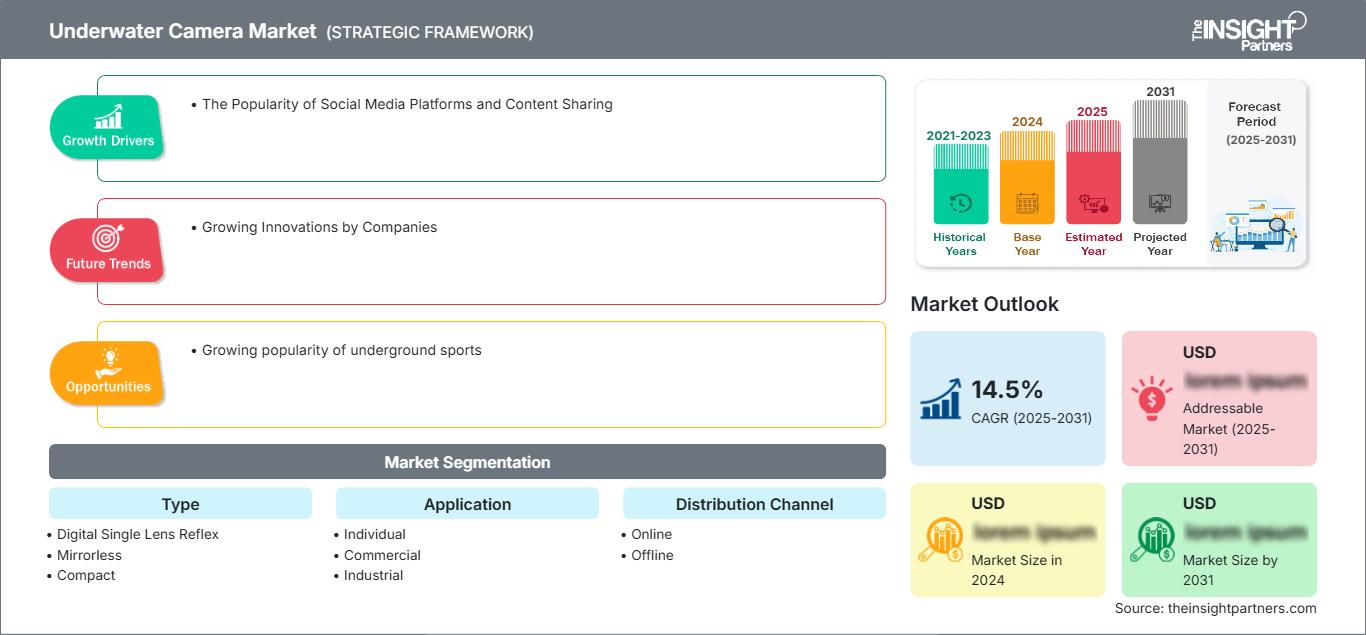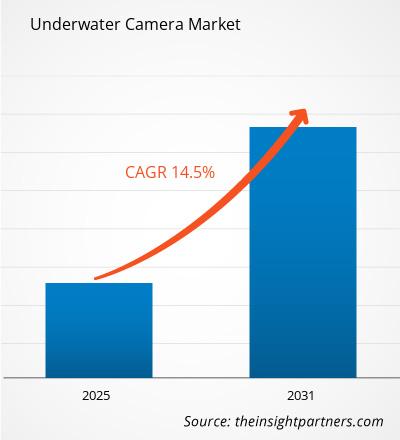Si prevede che il mercato delle fotocamere subacquee raggiungerà i 25,54 miliardi di dollari entro il 2031, rispetto agli 8,64 miliardi di dollari del 2023. Si prevede che il mercato registrerà un CAGR del 14,5% tra il 2023 e il 2031. La crescente popolarità degli sport underground rimarrà probabilmente un trend chiave nel mercato.
Analisi del mercato delle fotocamere subacquee
- Le fotocamere subacquee utilizzate nella fotografia turistica e commerciale sono due fattori chiave del mercato. La disponibilità di fotocamere robuste e impermeabili per riprese in tutte le condizioni atmosferiche ha un impatto significativo sul mercato delle fotocamere subacquee. Anche il crescente interesse per la fotografia e la videografia come hobby è un fattore cruciale.
- Con la ripresa del turismo in tutto il mondo, le persone stanno esplorando luoghi unici sott'acqua. Le fotocamere subacquee hanno un grande potenziale nel settore dei documentari e del turismo subacqueo. Il mercato delle fotocamere subacquee può trarre vantaggio dall'adozione di fotocamere subacquee nel settore della fauna marina.
- La crescita è attribuita ad aziende produttrici di fotocamere subacquee come Nikon, Canon e altre. La crescente popolarità della fotografia subacquea tra gli adolescenti stimola lo sviluppo del mercato regionale.
Panoramica del mercato delle fotocamere subacquee
- Una fotocamera subacquea è un dispositivo specializzato per catturare immagini e video sotto la superficie dell'acqua. Trova utilità in vari scenari, tra cui la fotografia durante il nuoto, lo snorkeling o tramite veicoli subacquei telecomandati.
- Alcune fotocamere subacquee sono persino dotate di funzionalità di automazione, scendendo senza sforzo dalla superficie dell'acqua per registrare autonomamente contenuti visivi. Mentre alcune fotocamere sono specificamente progettate per applicazioni subacquee, tra cui le moderne fotocamere digitali impermeabili, altre progettate per condizioni asciutte possono essere utilizzate sott'acqua con custodie protettive aggiuntive per proteggerle dall'acqua e dalla pressione.
Personalizza questo rapporto in base alle tue esigenze
Potrai personalizzare gratuitamente qualsiasi rapporto, comprese parti di questo rapporto, o analisi a livello di paese, pacchetto dati Excel, oltre a usufruire di grandi offerte e sconti per start-up e università
Mercato delle fotocamere subacquee: Approfondimenti strategici

- Ottieni le principali tendenze chiave del mercato di questo rapporto.Questo campione GRATUITO includerà l'analisi dei dati, che vanno dalle tendenze di mercato alle stime e alle previsioni.
Driver e opportunità del mercato delle fotocamere subacquee: la popolarità delle piattaforme social e la condivisione di contenuti
Potrai personalizzare gratuitamente qualsiasi rapporto, comprese parti di questo rapporto, o analisi a livello di paese, pacchetto dati Excel, oltre a usufruire di grandi offerte e sconti per start-up e università
Mercato delle fotocamere subacquee: Approfondimenti strategici

- Ottieni le principali tendenze chiave del mercato di questo rapporto.Questo campione GRATUITO includerà l'analisi dei dati, che vanno dalle tendenze di mercato alle stime e alle previsioni.
- La crescita delle piattaforme social e il desiderio di condividere esperienze uniche con familiari, follower e amici hanno avuto un impatto significativo sulla domanda di fotocamere subacquee. Le piattaforme social sono diventate una parte fondamentale della vita di tutti, fungendo da piattaforme di connessione ed espressione personale. Gli influencer che si concentrano su avventure, viaggi e attività all'aria aperta integrano spesso contenuti subacquei nei loro feed per offrire un'esperienza immersiva ai propri follower. L'approvazione degli influencer e l'uso di fotocamere subacquee hanno influenzato in modo sostanziale le decisioni di acquisto del pubblico, offrendo così opportunità vantaggiose per il mercato delle fotocamere subacquee.
- Inoltre, le fotocamere subacquee scattano foto e registrano video di sport e attività subacquee. Le fotocamere tradizionali non sono adatte alla fotografia e ai video subacquei poiché i loro circuiti integrati hanno una protezione limitata e non sono progettate per condizioni estreme come acqua o neve. Le fotocamere subacquee sono compatte, leggere, progettate per condizioni difficili e funzionano in modo efficiente in un ambiente industriale. Possono essere indossate da una persona sott'acqua. Queste fotocamere vengono utilizzate per scattare immagini subacquee ad alta velocità e di alta qualità. Pertanto, le foto scattate con fotocamere subacquee vengono utilizzate dagli influencer per aumentare i propri follower. Pertanto, la crescente popolarità delle piattaforme di social media e la condivisione di contenuti sta rafforzando la domanda di fotocamere subacquee nel mercato globale.
Innovazioni in crescita da parte delle aziende
- Le aziende investono continuamente in ricerca e sviluppo, con il risultato di migliorare la qualità delle immagini, aumentare la durata e offrire funzionalità specializzate come modalità subacquee e funzionalità di correzione automatica.
- Diverse aziende stanno lanciando vari tipi di fotocamere subacquee. Ad esempio, nel luglio 2024, ReelData, il produttore di Halifax di intelligenza artificiale per le operazioni di acquacoltura, ha lanciato il suo primo prodotto fisico: una fotocamera subacquea pensata per integrarsi con i sistemi informatici degli operatori di acquacoltura. La larghezza di banda e le capacità di compressione della fotocamera sono studiate per funzionare bene con i sistemi di intelligenza artificiale e il dispositivo stesso è impermeabile e sufficientemente robusto per l'uso in una vasta gamma di ambienti difficili.
- Tali innovazioni da parte degli operatori del mercato stanno creando un'opportunità per la crescita del mercato delle fotocamere subacquee nel periodo previsto.
Analisi della segmentazione del rapporto sul mercato delle fotocamere subacquee
I segmenti chiave che hanno contribuito alla derivazione dell'analisi del mercato delle fotocamere subacquee sono tipo, applicazione e canale di distribuzione.
- In base al tipo, il mercato delle fotocamere subacquee è suddiviso in reflex digitale a obiettivo singolo (DSLR), mirrorless e compatte.
- In base all'applicazione, il mercato è suddiviso in individuale, commerciale e industriale.
- In base al canale di distribuzione, il mercato è suddiviso in online e offline.
Analisi della quota di mercato delle fotocamere subacquee per area geografica
- Il rapporto sul mercato delle fotocamere subacquee comprende un'analisi dettagliata di cinque principali regioni geografiche, che include le dimensioni attuali e storiche del mercato e previsioni per il periodo 2021-2031, che coprono Nord America, Europa, Asia-Pacifico (APAC), Medio Oriente e Africa (MEA) e America meridionale e centrale.
- Ogni regione è ulteriormente suddivisa nei rispettivi paesi. Questo rapporto fornisce analisi e previsioni per oltre 18 paesi, coprendo le dinamiche del mercato delle fotocamere subacquee, come fattori trainanti, tendenze e opportunità che influenzano i mercati a livello regionale.
- Inoltre, il rapporto include l'analisi PEST, che prevede lo studio dei principali fattori che influenzano il mercato delle fotocamere subacquee in queste regioni.
Mercato delle fotocamere subacquee
Le tendenze regionali e i fattori che influenzano il mercato delle fotocamere subacquee durante il periodo di previsione sono stati ampiamente spiegati dagli analisti di The Insight Partners. Questa sezione illustra anche i segmenti e la geografia del mercato delle fotocamere subacquee in Nord America, Europa, Asia-Pacifico, Medio Oriente e Africa, America meridionale e centrale.
Ambito del rapporto sul mercato delle telecamere subacquee
| Attributo del rapporto | Dettagli |
|---|---|
| Dimensioni del mercato in 2024 | US$ XX million |
| Dimensioni del mercato per 2031 | US$ XX Billion |
| CAGR globale (2025 - 2031) | 14.5% |
| Dati storici | 2021-2023 |
| Periodo di previsione | 2025-2031 |
| Segmenti coperti |
By Tipo
|
| Regioni e paesi coperti | Nord America
|
| Leader di mercato e profili aziendali chiave |
|
Densità degli operatori del mercato delle telecamere subacquee: comprendere il suo impatto sulle dinamiche aziendali
Il mercato delle fotocamere subacquee è in rapida crescita, trainato dalla crescente domanda degli utenti finali, dovuta a fattori quali l'evoluzione delle preferenze dei consumatori, i progressi tecnologici e una maggiore consapevolezza dei vantaggi del prodotto. Con l'aumento della domanda, le aziende stanno ampliando la propria offerta, innovando per soddisfare le esigenze dei consumatori e sfruttando le tendenze emergenti, alimentando ulteriormente la crescita del mercato.

- Ottieni il Mercato delle fotocamere subacquee Panoramica dei principali attori chiave
Il mercato delle fotocamere subacquee viene valutato raccogliendo dati qualitativi e quantitativi dopo ricerche primarie e secondarie, che includono importanti pubblicazioni aziendali, dati di associazioni e database. Di seguito sono elencati alcuni degli sviluppi nel mercato delle fotocamere subacquee:
- Ace Aquatec ha aggiunto un altro prodotto innovativo alla sua gamma con il lancio di A-BIOMASS, un sistema di telecamere automatizzato con intelligenza artificiale che rivoluzionerà l'acquisizione di dati sulla biomassa per gli allevatori ittici di tutto il mondo. A-BIOMASS, un sistema di telecamere subacquee avanzato, promette di trasformare il modo in cui gli allevatori ittici di tutto il mondo monitorano e classificano i loro stock ittici utilizzando l'apprendimento automatico e l'intelligenza artificiale (IA) per una precisione millimetrica in tempo reale. (Fonte: Ace Aquatec, sito web aziendale, agosto 2023)
- Fujifilm ha lanciato QuickSnap. Questa fotocamera impermeabile è una fotocamera usa e getta che può essere utilizzata fino a 35 piedi sott'acqua con caratteristiche come 27 esposizioni di pellicola ISO 800, immagini a colori e un obiettivo a fuoco fisso da 32 mm f/10. (Fonte: Fujifilm, Newsletter, marzo 2021).
Copertura e risultati del rapporto sul mercato delle fotocamere subacquee
Dimensioni e previsioni del mercato delle fotocamere subacquee (2021-2031) Il rapporto fornisce un'analisi dettagliata del mercato che copre le seguenti aree:
- Dimensioni e previsioni del mercato delle telecamere subacquee a livello globale, regionale e nazionale per tutti i principali segmenti di mercato coperti dall'ambito.
- Tendenze del mercato delle telecamere subacquee e dinamiche di mercato come fattori trainanti, vincoli e opportunità chiave.
- Analisi dettagliata delle cinque forze PEST/Porter e SWOT.
- Analisi del mercato delle telecamere subacquee che copre le principali tendenze del mercato, il quadro globale e regionale, i principali attori, le normative e i recenti sviluppi del mercato.
- Analisi del panorama industriale e della concorrenza che copre la concentrazione del mercato, l'analisi della mappa termica, i principali attori e i recenti sviluppi per il mercato delle telecamere subacquee.
- Profili aziendali dettagliati.
- Analisi storica (2 anni), anno base, previsione (7 anni) con CAGR
- Analisi PEST e SWOT
- Valore/volume delle dimensioni del mercato - Globale, Regionale, Nazionale
- Industria e panorama competitivo
- Set di dati Excel
Report recenti
Rapporti correlati
Testimonianze
Motivo dell'acquisto
- Processo decisionale informato
- Comprensione delle dinamiche di mercato
- Analisi competitiva
- Analisi dei clienti
- Previsioni di mercato
- Mitigazione del rischio
- Pianificazione strategica
- Giustificazione degli investimenti
- Identificazione dei mercati emergenti
- Miglioramento delle strategie di marketing
- Aumento dell'efficienza operativa
- Allineamento alle tendenze normative




















 Ottieni un campione gratuito per - Mercato delle fotocamere subacquee
Ottieni un campione gratuito per - Mercato delle fotocamere subacquee